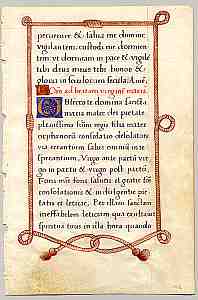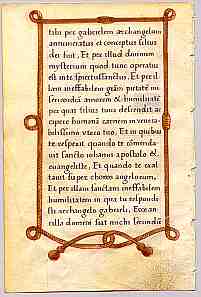

This leaf comes from a book of hours produced in France around 1520 to 1540. By this date, printed books of hours were being produced in Paris, so this represents the last moments of the manuscript tradition for this very popular work. The script, a humanistic minuscule, has many features of style derived from contemporary typefaces and does not look like a comfortable script to write. While the page has the traditional features of rubric headings and illuminated initials, the gold washed rope border is a novel feature. There might be a temptation to call it Renaissance styling if there was any association between the rediscovery of Classical literature, the development of humanistic thinking, new scientific methods of pictorial depiction and a pile of old rope, but as I cannot think of one, let us just say it departs from the traditional medieval page design.
The text, beginning from the large illuminated initial, is the prayer to the Virgin Mary generally referred to as the Obsecro Te, after the first two words. This is one of a number of prayers that can be found in the book of hours that allows the lay user into intimate communication with the Virgin, without intercession by a member of the clergy. It is preceded on the page by the end of another Latin prayer. It is intriguing that the wording differs slightly in several places from that given in the translation cited below, indicating that even a relatively standard text developed variants through the manuscript tradition.
It is tempting to wonder whether a book like this would have been a high status item because of its painstaking method of production in the new era of larger scale reproduction by printing, or whether it was simply produced for those old fashioned folks who were having nothing to do with this new devilish technology. I guess we shall never know.
| overview | initials | text | alphabet | abbreviations | exercises | transcript | translation |
If you are looking at this page without frames, there is more information about medieval writing to be found by going to the home page (framed) or the site map (no frames).